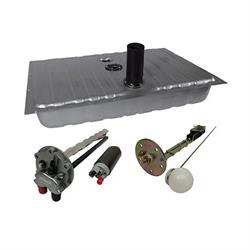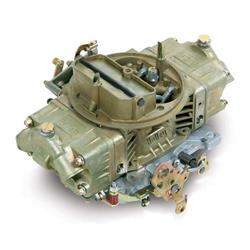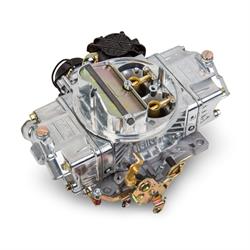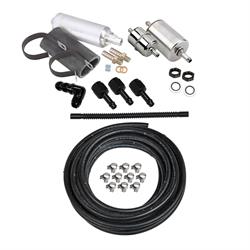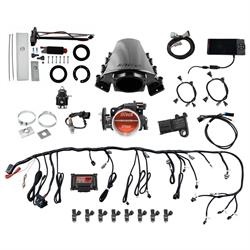EFI VS Carb | Is Converting Carb to EFI Worth it | Pros & Cons
Difference Between EFI and Carburetor
Both carburetors and electronic fuel injection (EFI) are ways to deliver fuel to be burned in an engine’s combustion chamber. However, the difference between EFI and carburetor fuel delivery is vastly unlike. The carburetor has been the main fuel metering and delivery device for over 100 years, only having been replaced “recently” by EFI in the last 40 years or so. Yes, there were some mechanical EFI systems in production in the 1950s but we’re referring to mainstream EFI utilization in new cars here. While you can certainly still find new carburetors to buy (and EFI systems as well), as far as production vehicle use is concerned you will not see an OEM carburetor after the mid to late 1980s for domestic vehicles. The use of EFI was all but mandated by emissions and fuel economy, as well as driver satisfaction for throttle response, cold starting, and the like, in the late 1980s, replacing OE carburetor use. Is fuel injection better than carburetor usage? Read on.
The carburetor uses Bernoulli’s principle that a fluid or gas moving from a high pressure area to a low pressure area will accelerate. This is accomplished in the carburetor via a venturi. The venturi accelerates the incoming air, which pulls the liquid fuel from the fuel bowl (via a jet), and mixes the two, atomizing the fuel as it leaves the carburetor and enters the intake manifold. The inlet path must maintain enough velocity to keep the fuel in suspension with the air, otherwise fuel can drop out of suspension and puddle in the intake or even the cylinder head’s intake path, creating a lean condition. Furthermore, the jet sizing is relative to a certain fuel flow, meaning that jets for great tip in and part throttle use aren’t the best for max rpm performance, and vice versa. As a mechanical device there are many fuel circuits and components that make up the carburetor’s fuel system. The choke, accelerator pump, idle circuit, main metering circuit, power valve, and more are all critical aspects that must work together “handing off” the engine’s needs as throttle input and rpm change.
Modern EFI, on the other hand, handles fuel metering electronically via a computer called an ECM (engine control module) or PCM (powertrain control module), with the difference being the PCM usually controls an electronic automatic transmission at a minimum and in many OE applications can control locking differentials and other drivetrain components. The computer uses various inputs called sensors to determine throttle position/angle, rpm, engine coolant temperature, inlet air temperature, and more. The computer then uses these inputs, along with data tables in the computer itself to control various outputs to deliver the precise amount of air to the engine and fuel through the fuel injectors located in the throttle body (TBI) or at each intake runner (port EFI) for the best air/fuel ratio for the engine’s commanded needs in a more accurate manner than the typical carburetor can. While there are several TBI-based EFI systems on the market, Edelbrock EFI is one of the main proponents of port injected retrofits.
CFM Calculation
Both carburetors and EFI systems are usually rated via CFM (cubic feet per minute) of airflow. However, their ratings are not a true apple to apple comparison. Carb and EFI plug & play kits are all rated by CFM, true, but EFI is rated by a CFM range and is adjustable vs carb CFM, which is the carburetor’s maximum airflow rating.
Carburetor CFM Ratings
The CFM rating typically found in a carburetor’s description or product name equates to the maximum airflow capability of that unit in which it can deliver in one minute. Choosing the correct CFM rating for your carburetor is critical to ensuring your engine performs at its best performance wise. The maximum CFM needed is determined by several factors, including displacement, volumetric efficiency, rpm range, usage type, and more. To get an accurate CFM rating, aside from the math we explain in our Toolbox article the best carburetor for specific applications is to be realistic about your engine's volumetric efficiency (VE). For example, if your calculations show your engine requires 580 CFM at maximum rpm a 600-cfm carburetor will satisfy your engine’s needs.
EFI CFM Rating
Many aftermarket EFI systems will note a CFM range in their product information. This is because the fuel injection system can vary the fuel flow through the injectors (among other system outputs) in real time to provide the most efficient air/fuel ratio through any driving conditions. This is the main advantage of fuel injection over carburetion. So, while an EFI system may still list a maximum CFM capability, it is much more forgiving to install a “too large” of an EFI system on an engine than it is to do the same for a carburetor. Using the same engine example above of a 580 CFM requirement, an 800 CFM EFI system can be installed (possibly for use with additional performance upgrades in the future) without issue, as it will only provide the air and fuel the engine needs to run at optimum efficiency. This provides greater versatility to the end user, as you can buy an EFI system with future upgrades in mind that will require more CFM and not have to replace your EFI components. Whereas, if you make significant airflow upgrades on a carbureted engine you will need to move to a larger carburetor (CFM wise) to be able to support said upgrades with the right amount of fuel.
Carburetor vs Fuel Injection Advantages and Disadvantages
When it comes to EFI vs carburetor, there are many factors that come into the decision process. Application, usage, existing fuel system or fuel system component upgrades/needs, and more. The pros and cons of both fuel delivery systems are mapped out below with carburetor vs fuel injection diagram assistance to give you some things to consider which may be best for you when it comes to carburetor versus fuel injection pros cons.
Advantages:
- Simplicity: Carburetors are relatively simple mechanical devices, making them easier to understand and work on for some enthusiasts.
- Affordability: Carburetors are generally less expensive to purchase and maintain compared to fuel injection systems.
- Compatibility: Carburetors can often be fitted to older or vintage engines without significant modifications, making them a popular choice for classic car enthusiasts.
- Fuel System Needs: Generally, carbureted applications can use a basic engine driven fuel pump or low pressure electric pump and a single supply line.
Disadvantages:
- Tuning Dependency: Carburetors require periodic adjustment for optimal performance, especially in changing environmental conditions or with engine modifications.
- Fuel Efficiency: Carburetors are typically less precise in fuel delivery compared to fuel injection, which can result in lower fuel efficiency.
- Emissions: Carbureted engines often produce higher emissions compared to fuel-injected engines due to less precise fuel metering.
- Fuel Leaks/Smell: With age fuel bowl gaskets and other parts of the carburetor can fail, causing fuel leaks and fuel vapor to build up in your garage or shop.
Advantages:
- Precise Fuel Metering: Fuel injection systems can precisely control the amount of fuel delivered to the engine, leading to improved fuel efficiency and performance.
- Emissions: Fuel injection systems can help engines meet stricter emissions standards by delivering precise air-fuel ratios and optimizing combustion.
- Self-Tuning Capabilities: Many modern fuel injection systems feature self-tuning capabilities, adjusting parameters in real-time based on sensor feedback for optimal performance in varying conditions.
- Enclosed Fuel System: Modern EFI uses O-ring seals, and the fuel injectors close off the fuel system when not running, reducing, or eliminating any fuel vapor smell.
Disadvantages:
- Complexity: Fuel injection systems are more complex than carburetors, requiring sophisticated electronic components and sensors.
- Cost: Fuel injection systems are generally more expensive to purchase and maintain compared to carburetors, especially for aftermarket upgrades.
- Compatibility: Retrofitting a fuel injection system onto an older engine may require significant modifications and expense compared to installing a carburetor.
- Major Fuel System Needs: An EFI system requires not only a supply line, but a return line plumbed, pre and post pump fuel filters, and a high pressure fuel pump (preferably in-tank located), which all adds to the cost and complexity of an EFI installation.
Four Barrel Carburetor Diagram
Carb Circuit Diagram
EFI Diagram
EFI Circuit Diagram
Sensors: EFI uses several sensors on various parts of the engine that provide input to the computer, including throttle position, engine coolant temperature, crankshaft position, inlet air temperature, and more.
ECM/PCM Processing: Using pre-calibrated maps and tuning parameters in the computer’s memory, the various sensor inputs are processed and compared to these data points to determine the ideal air/fuel mixture, ignition timing, and other various outputs for optimum performance and efficiency.
Fuel Delivery: The EFI system’s computer provides a signal to the fuel injectors (one of the system’s outputs) to open and close the fuel injectors for a specific time, called a duty cycle, to provide a precise delivery of fuel to the engine based on the computer’s calculations.
Ignition Timing: Not all aftermarket EFI systems are capable of ignition control, however, the ones that can are able to adjust ignition timing “on the fly” to provide the most complete combustion of the air and fuel in the combustion chamber, providing peak performance without spark knock.
Adaptive Learning: You will find most aftermarket EFI systems are capable of adaptive learning, or “self-tuning” as some call it. This is a feature where the computer can continually adjust fuel demand and ignition timing (among other things) based upon real-world driving conditions for the best performance and efficiency. Over time this adaptive learning function provides for changes in engine condition (wear) or additional modifications that increase airflow.
Diagnosis and Troubleshooting: Just like OEM fuel injection, aftermarket EFI systems provide a way to troubleshoot any issues and provide diagnostic features to test most of the EFI system’s components. Many offer a “check engine light” output option or will provide a similar functionality through the system’s touch screen display, which is also where trouble codes can be retrieved.
EFI Carb Replacement
Updating a carbureted engine application with a bolt-on throttle body-style EFI carb replacement or retrofit is a popular option, as the retrofit unit simply takes the place of the carburetor. This means that if you have already spent good money on a performance intake manifold for your engine in the past it will not be wasted when converting to this style of EFI. There are several applications where these bolt-on EFI systems have become quite popular.
Street Cars and Daily Drivers
Since EFI systems optimize the air/fuel ratio based upon demand and operating conditions, which provides a more complete combustion and lower fuel consumption, they are perfect for vehicles that are driven daily. Commuting to work every day where you want exceptional cold start abilities, great fuel economy, and improved throttle response over what a traditional carburetor can bring to the table is where these EFI retrofits shine. The idle quality and driveability are also key factors that are improved with EFI as well.
Classic Cars and Restomods
Classic vehicles that are used only occasionally for cars & coffee and cruise night type events are the perfect candidate for converting to EFI. These cars often have older engines that are carbureted yet sit for prolonged periods of time. This usually creates extended cranking intervals due to evaporated fuel, and often you will find issues with the carburetor’s intricate fuel circuits being clogged from lack of use as well. Bolt on direct-fitting throttle body EFI retrofits, such as the Holley Sniper or FiTech EFI units are a great solution to these carburetor issues on vehicles that sit for prolonged periods between use. These systems will fit under stock or period looking air filter housings and at first glance do not give away their modern fuel injection internals, perfect for keeping that vintage vibe going on your classic while enjoying easier starting, better fuel economy, and better driveability. If you’re considering the offerings from FiTech be sure to check out our FiTech EFI reviews and FiTech troubleshooting guide for tips and tricks for best operation.
Off-road and Tow Vehicles
When it comes to off-road vehicles or those towing a heavy load (such as towing a camper or car trailer) the benefits of upgrading from a carburetor to EFI are strong here as well. Carburetors do not do well with altitude changes or steep driving angles where fuel can exit the fuel bowl through a vent and flood the carburetor. Furthermore, when towing the extra torque provided by an EFI system’s efficiency is better than any carburetor, providing you with additional performance to get up to and maintain highway speeds quickly and safely. This is all possible due to the fuel injection system’s ability to precisely control the air/fuel ratio as needed for smoother acceleration, increased torque, and reduced strain on the engine under these greater loads.
Convert EFI to Carburetor
While we have been singing the praises of converting the antiquated carburetor on an engine to the more precise application of fuel injection, there are indeed some cases where converting from EFI (usually complicated factory setups) back to a carburetor is warranted. A perfect example of where you might wish to convert EFI to carburetor is modern production engines such as the Gen III Hemi, Ford’s new Godzilla 7.3L truck engine, and others that may be too difficult to retain the factory EFI components in a swap scenario. In these cases, converting back to a carburetor does have merit.
Modern Fuel-Injected V8 Swaps
Often the problem with wanting the “latest and greatest” from a swap standpoint is that the only way to retain the factory EFI is to completely wire your project with the entire vehicle harness from the donor vehicle. Essentially, the donor vehicle thinks it is still running, but it is now living in a classic vehicle. This is a lot of work and requires extensive electrical and wiring knowledge to tackle. As such, many will revert to the simplistic nature of carburetion. In some cases, there are carbureted intake manifolds available to allow a bolt-on swap to run a carbureted LS engine, whereas other, less popular engine swap options (or brand new engines just coming from the factory) you will have to fabricate your own induction setup/adapter to run a carburetor.
Dedicated Drag Applications
All the things we praise EFI for, including fuel economy, low speed throttle response, and more are not “mission critical” needs when it comes to drag racing. For drag applications it is all about pinning the throttle blades to wide open throttle (WOT) for maximum horsepower and consistent acceleration. Not to mention that when it comes to a drag car the simpler things are the better. With a carburetor and mechanical or external electric fuel pump and standard ignition setup things are much easier to tune and diagnose if any issues should arise between passes. In extreme cases factory EFI systems also weigh a lot more than a simple carburetor and ignition. Removing substantial amounts of wiring, fuel rails, fuel lines, computers, and more shave critical weight.
Tuning Simplicity
For some the pure simplicity of a carb engine vs fuel injection as a means of fuel delivery to the engine far outweighs the benefits of using EFI. Simple hand tools are all you need to make carburetor adjustments to air/fuel mixture, idle speed, fuel flow, and more. This makes carburetors much more accessible to the masses from a tuning standpoint with a learning curve that isn’t nearly as steep as custom EFI tuning. Converting to a carburetor eliminates the need for specialized tuning software, diagnostic equipment, and knowledge of EFI system intricacies, simplifying the tuning process and reducing potential troubleshooting challenges.
EFI vs Carburetor Pros & Cons
We’ve discussed the benefits of converting from a carburetor to EFI, and why you may wish to retain your carburetor in certain circumstances. We created a decision matrix below on EFI vs carb that will help in your decision as to the best option for your needs when it comes to your engine’s fuel system selection.
Decision Matrix Description:
- Initial Cost: Carburetors are cheaper compared to fuel injection systems, which tend to be the most expensive option.
- Reliability: Fuel injection systems are generally more dependable in all driving conditions compared to carburetors.
- Installation Complexity: Carburetors are easier to install and tune than fuel injection systems, but once installed, EFI offers a balance between ease of installation and tuning complexity.
- Ease of Adjustment: Self-tuning EFI systems are the easiest to adjust, followed by adjustable carburetor upgrades.
- Cold Start Performance and Throttle Response: EFI systems provide superior cold start performance and throttle response compared to carburetors.
- Fuel Efficiency: EFI systems offer excellent fuel efficiency due to precise fuel delivery based on engine load and conditions.
- Emissions: EFI systems provide excellent emissions control by precisely adjusting air-fuel ratios and ignition timing.
- Adaptability to Power Adders: EFI systems excel in adaptability to engine modifications and compatibility with forced induction setups, offering superior control over air-fuel ratios and ignition timing.
Best Aftermarket Fuel Injection EFI Kit
There are many choices when considering aftermarket EFI solutions. You can read our thoughts on the best aftermarket fuel injection for your needs and then peruse the various offerings at the links below.
Best Carburetor Kit
If you’re firmly in the “carburetion is best” camp, no worries, we have Holley carb and Edelbrock carb offerings to suit your needs, among all our carburetor recommendations.








